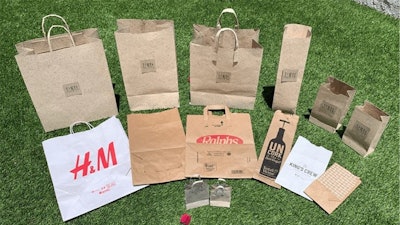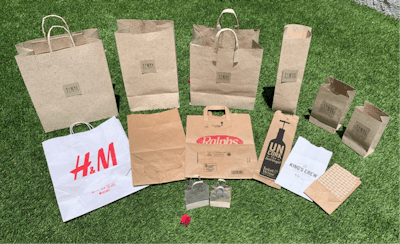

A comparison of TINY e PAPER products to those used by other brands
“[We] were surrounded by all of this tree trash. There were mounds of paper [packaging] for this tiny little vape pod and this battery,” Halverson says.
The waste in the industry inspired Halverson to find a solution. In 2017, she founded TINY e PAPER Co., which produces a full gamut of paper products made entirely from hemp.
“I had the idea that if we could get … the cannabis industry to switch to a self-sustaining business model, then we could A, legitimize ourselves as the cannabis industry ... and B, we could become a model to every other industry about what it truly means to make responsible and sustainable business decisions about how we run our companies,” Halverson says. “Especially if you are already in the industry either selling a CBD brand, a hemp product, or THC, you’ve already acknowledged you love the plant and love the industry, so why are you not wrapping your products in the plant you believe in?”
Finding the Formulation
Halverson spent four months conducting the necessary research and development to create 100% hemp paper products on a commercial scale.
The paper can be made of a 50/50 blend of hemp stalks and post-extraction waste from CBD manufacturers—another way she’s working to reduce waste. “Companies are giving me their waste for free since I’m doing them the favor of taking it off their hands,” she says.
Creating hemp paper starts with processing the stalks, oftentimes through decortication (though that is not always required). From there, she uses processes similar to those used to make tree pulp paper.
Halverson has partnered with a paper mill to turn the raw hemp into pulp and create commercial rolls of paper. The mill can turn the rolls of paper into sheets with a range of sizes and thicknesses. These can be used to create nearly any paper-based product, including boxes, printer paper, toilet paper, paper towels, paper bags, business cards, and record sleeves.
Halverson says she doesn’t use harsh chemicals in her products, unlike some other paper product manufacturers that use bleach to make products white. Bleach produces a highly toxic byproduct called dioxin. And while dioxin is only found in trace amounts that are thought to be harmless in finished products, its usage can still wreak havoc on the environment.
Instead, Halverson uses hydrogen peroxide, which is generally considered safe for humans and the environment, to lighten her products. This means the lightest she can make her products is a “creamy white,” she says.
Beyond that, Halverson’s customers, most of whom are cannabis companies, can choose a variety of looks for their products, from the shade to the visible amount of grain.
“Every order right now is a custom order,” Halverson says.
Restoring the Supply Chain
Halverson currently does not source any of her hemp from the U.S. because of a lack of processing infrastructure. “[Hemp] is tough stuff to work with,” Halverson says, adding that because its fibers are so strong, machines used to process wood into paper need to be recalibrated to handle hemp.
Instead, TINY e PAPER’s hemp comes from Europe cleaned, mixed, chopped up, and ready to be made into a pulp.
However, Halverson is hoping to change that. She’s currently forming relationships with domestic partners to source the extracted side of her material. Halverson is also working to acquire her own industrial decorticator through a $5 million fundraising effort, which will help her fully process all the material herself. This will also allow her to purchase raw material directly from farmers in the U.S. at a fair price, she says.
“My entire focus and goal is to get the whole U.S. supply chain up and running. I am on a mission to make that happen,” Halverson says. “I am forming partnerships with all the pieces I need to complete the supply chain, from seed to sale. We need to support every single piece of this puzzle.”
The Future of Hemp Paper
Halverson acknowledges that hemp paper is set at a higher price than average paper and will likely always be.
“I liken it very much to lightbulbs. When many people buy bulbs, consumers are 90% of the time making the decision to pay up to 60% more for an LED bulb,” Halverson says. “I believe hemp paper purchasers will understand the same values of hemp and will expect to pay a little bit more for it.”
Halverson is optimistic for the future of hemp-based paper—especially as corporate giants like Amazon, Apple, and IKEA have added sustainability initiatives to their long-term goals, targeting packaging as a major area where they can improve. “Even the EPA has added packaging as one of its top 3 sustainability features all the way into 2022,” Halverson says, explaining one of the agency’s priority areas in its most recent Sustainable Materials Management Program Strategic Plan.
In addition to a growing movement toward sustainability, Halverson has also found that the COVID-19 pandemic has helped push companies toward thinking more about domestic options.
“All these vape cart companies and packaging companies had to buy American” amid shipping holdups caused by the pandemic, Halverson says, which boosted business for TINY e PAPER.
“The future is bright,” she adds.














